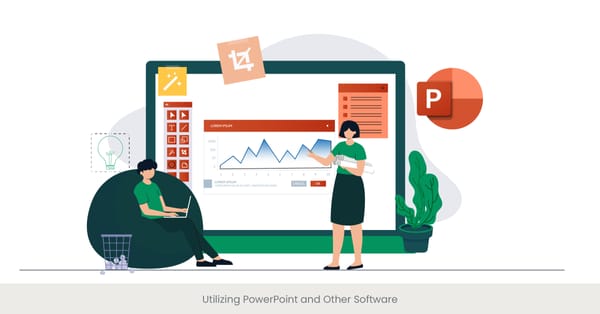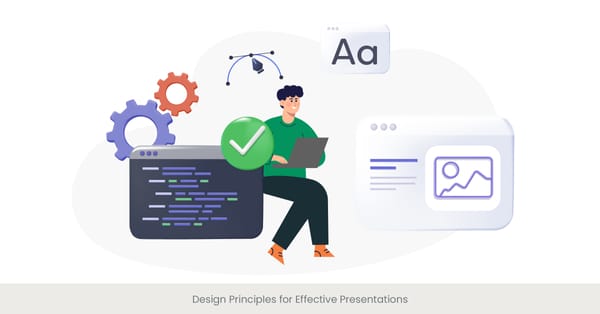
Mastering the art of delivery in presentations is not just about conveying information; it's about doing so in a way that is impactful, memorable, and engaging. Delivery techniques are the backbone of effective communication, helping speakers to connect with their target audience, hold their attention, and impart knowledge persuasively. Whether you are presenting in a boardroom, at a conference, or during a virtual meeting, the way you deliver your message can significantly influence your audience's perception and reactions.
Effective Body Language and Gestures
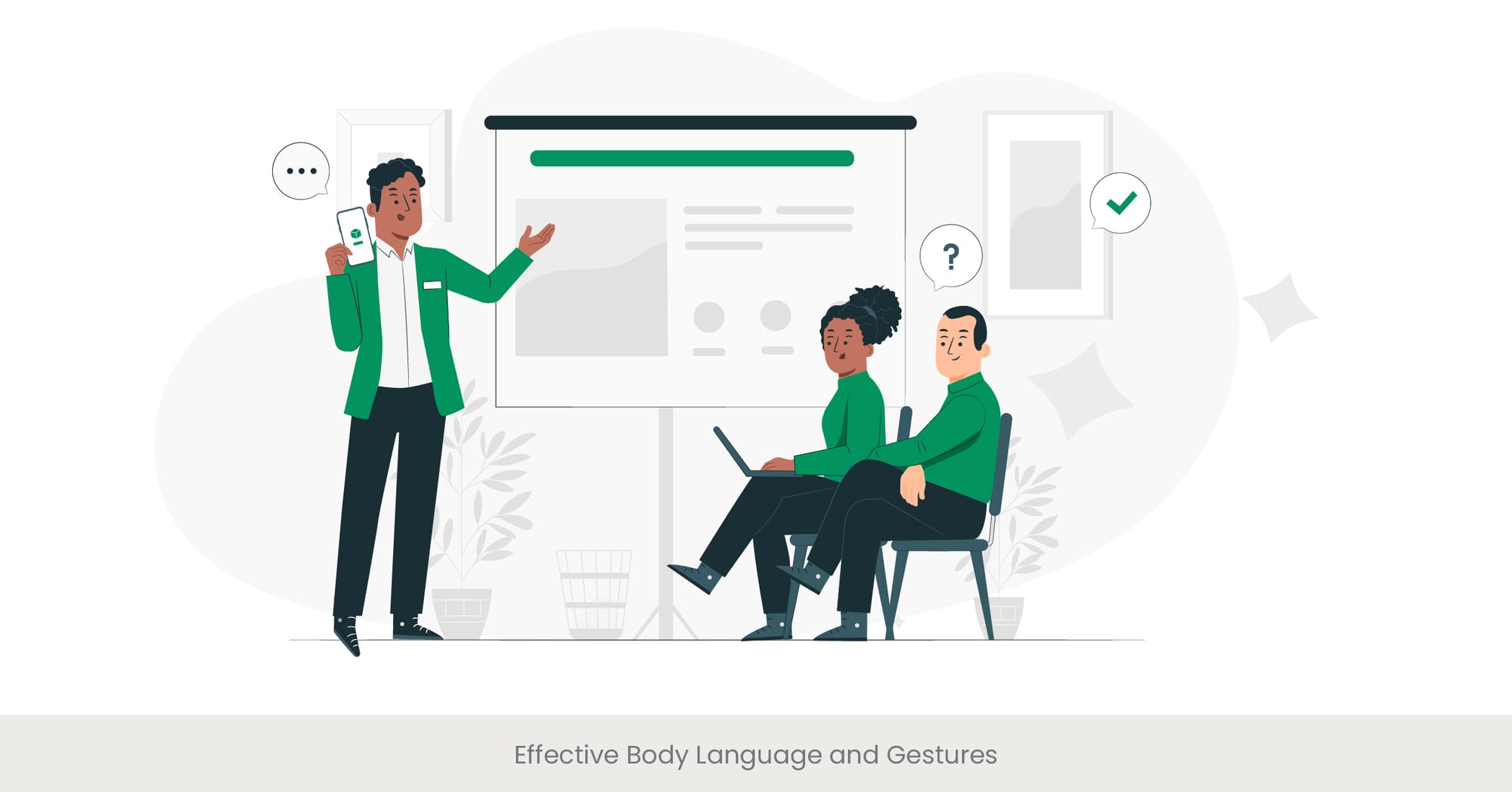
Expressive Communication: Harnessing the Power of Body Language
Body language and gestures are vital tools in the arsenal of a very effective presenter too. They can underline the importance of your words, evoke emotions, and enhance the clarity of your message. Effective body language transcends cultural barriers and can be more impactful than verbal communication. It includes the use of facial expressions, hand gestures, posture, and overall body movements.
The Foundation of Nonverbal Communication
Historically, body language has been a fundamental form of human communication. Studies suggest that nonverbal communication accounts for a significant portion of our daily interactions. In presentations, your body language helps to set the tone of the discourse and can be used strategically to emphasize key points. Understanding the psychology behind gestures and postures can transform your presentation from a mere speech to a compelling engagement.
Real-World Application and Impact
Consider the effectiveness of a TED Talk where the speaker walks confidently on stage, makes eye contact, and uses deliberate gestures to emphasize their points. Such nonverbal cues are instrumental in making an emotional connection with the audience, making the message more persuasive and memorable. Effective presenters like Steve Jobs used minimal yet powerful gestures that aligned perfectly with their verbal messages, making their presentations iconic.
Validating the Influence of Body Language
Research supports the efficacy of strategic body language in presentations. For instance, a study from UCLA indicated that up to 93% of communication effectiveness is determined by nonverbal cues. Another report highlighted how speakers who actively engage with their audience through direct eye contact and open gestures are perceived as more credible and authentic.
Using Voice and Tone for Impact
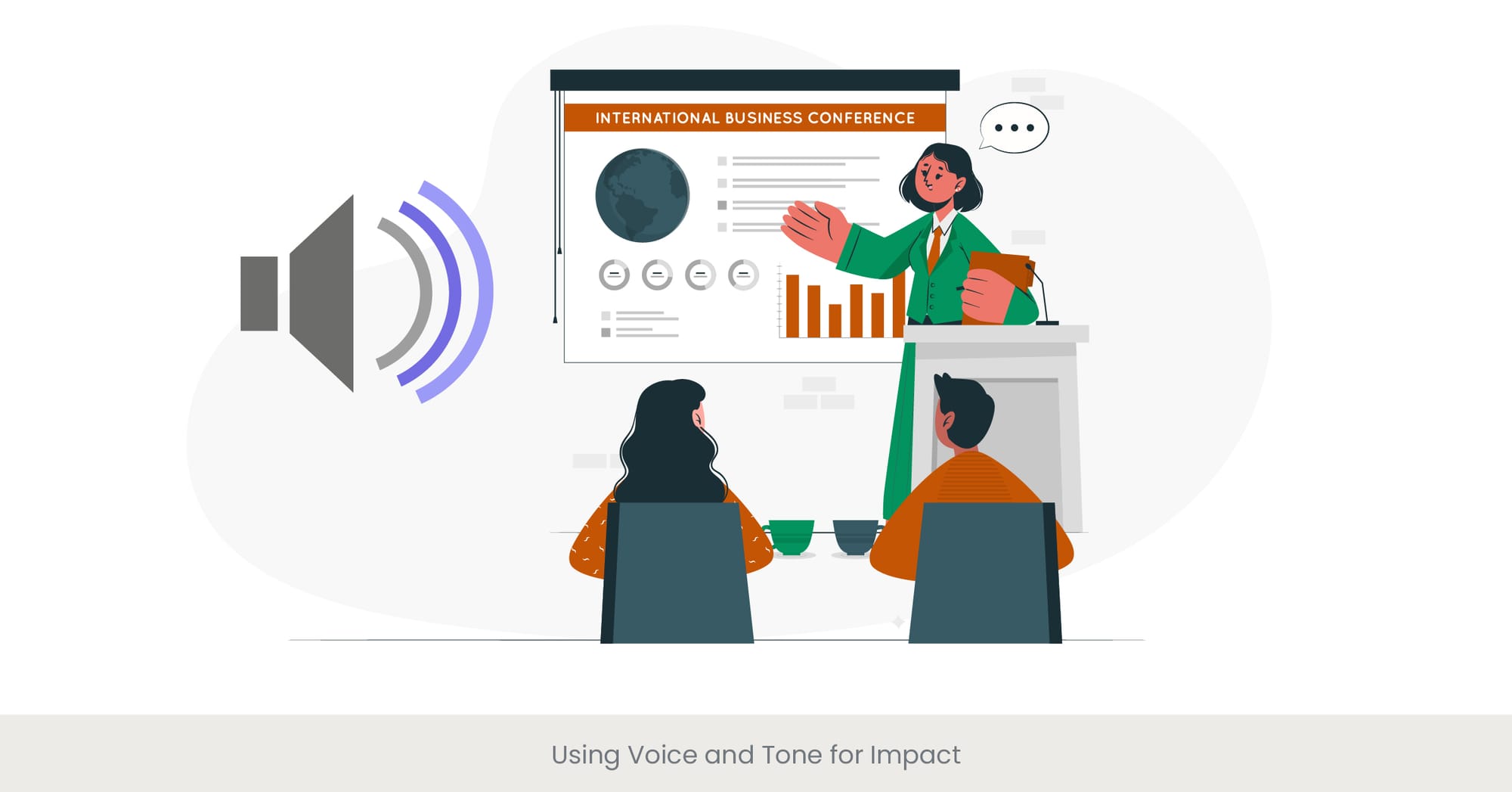
The Vocal Dynamics of Persuasive Speaking
Voice and tone are not just about how you speak sound; they're about how effectively you speak can convey your message and influence your audience. The way a presenter modulates their voice can significantly affect the audience's engagement and retention of the information presented. A well-modulated voice helps in emphasizing key points, conveying emotions, and adjusting the pace to suit the content and context of the speech.
The Role of Vocal Qualities in Effective Communication
Historically, great speakers have used their voice as a powerful tool to captivate and move their audiences. The tone of voice can convey authority, excitement, concern, or empathy, making the content more relatable and impactful. Vocal variety—changes in pitch, pace, and volume—helps maintain audience interest and prevents monotony, which can cause the listener's mind to wander.
Illustrating the Power of Voice with Real Examples
Consider the impact of Martin Luther King Jr.'s "I Have a Dream" speech, where his varying vocal intonations stirred the emotions of his audience, elevating the speech's impact. Similarly, in business presentations, a speaker's ability to adjust their vocal delivery to match the narrative—speaking slowly and softly to draw listeners in, or increasing volume to highlight a critical point—can significantly enhance the effectiveness of the communication.
Supporting Studies and Statistics
Research underscores the importance of vocal effectiveness in effective presentations too. Studies indicate that variations in vocal delivery can affect the persuasiveness of a speech and the speaker's perceived confidence and authority. For example, a study published in the Journal of Voice found that speakers who used a dynamic range of vocal pitches were rated as more engaging and competent than those who spoke in a monotone.
Managing Nervousness and Anxiety
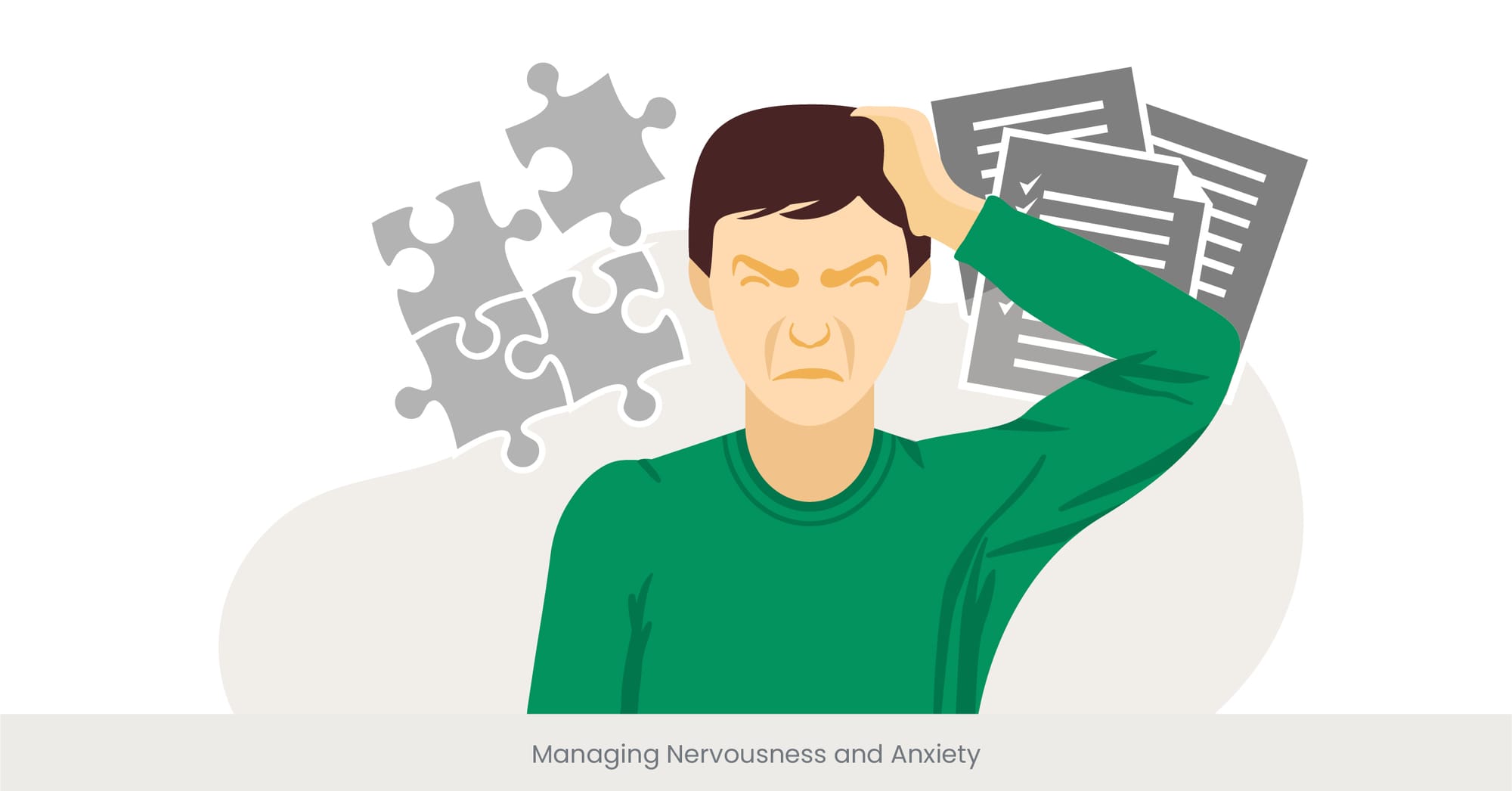
Conquering Stage Fright: Strategies for Calm and Confident Presentations
Even seasoned presenters can experience nervousness or anxiety before a speech, which can impact their delivery and audience engagement. Understanding and managing these feelings are crucial to delivering a powerful presentation. Techniques such as deep breathing, visualization, and positive affirmation can significantly reduce stress and enhance performance.
Historical and Psychological Perspectives on Presentation Anxiety
Anxiety in public speaking, often referred to as "stage fright," has been a well-documented phenomenon throughout history, affecting even the most experienced speakers. Psychologically, this type of anxiety is linked to the fear of judgment or negative evaluation by others. Overcoming this fear involves both mental and physical preparation strategies that can help develop and stabilize the speaker's emotions and boost their confidence.
Real-World Examples of Overcoming Presentation Anxiety
Public speaking champions and successful entrepreneurs often share stories in personal story, of how they overcame their fears. For instance, Warren Buffett, who was once terrified of public speaking, took a course in public speaking and practiced relentlessly until he became comfortable in front of an audience. These personal anecdotes and real-world examples serve as powerful testimonies to the effectiveness of facing and managing presentation-related anxieties.
Empirical Evidence and Advice from Experts
Research in the field of psychology offers various techniques proven to help reduce anxiety. Techniques such as the 'spotlight effect' reduction, where speakers are trained to understand that audiences notice their anxiety less than they might assume, can provide comfort and reduce speaker anxiety. Scholarly articles and expert studies suggest that preparation and practice are key to reducing anxiety, with data showing that well-prepared speakers experience significantly less stress compared to those who are not.
Maintaining Eye Contact and Attention
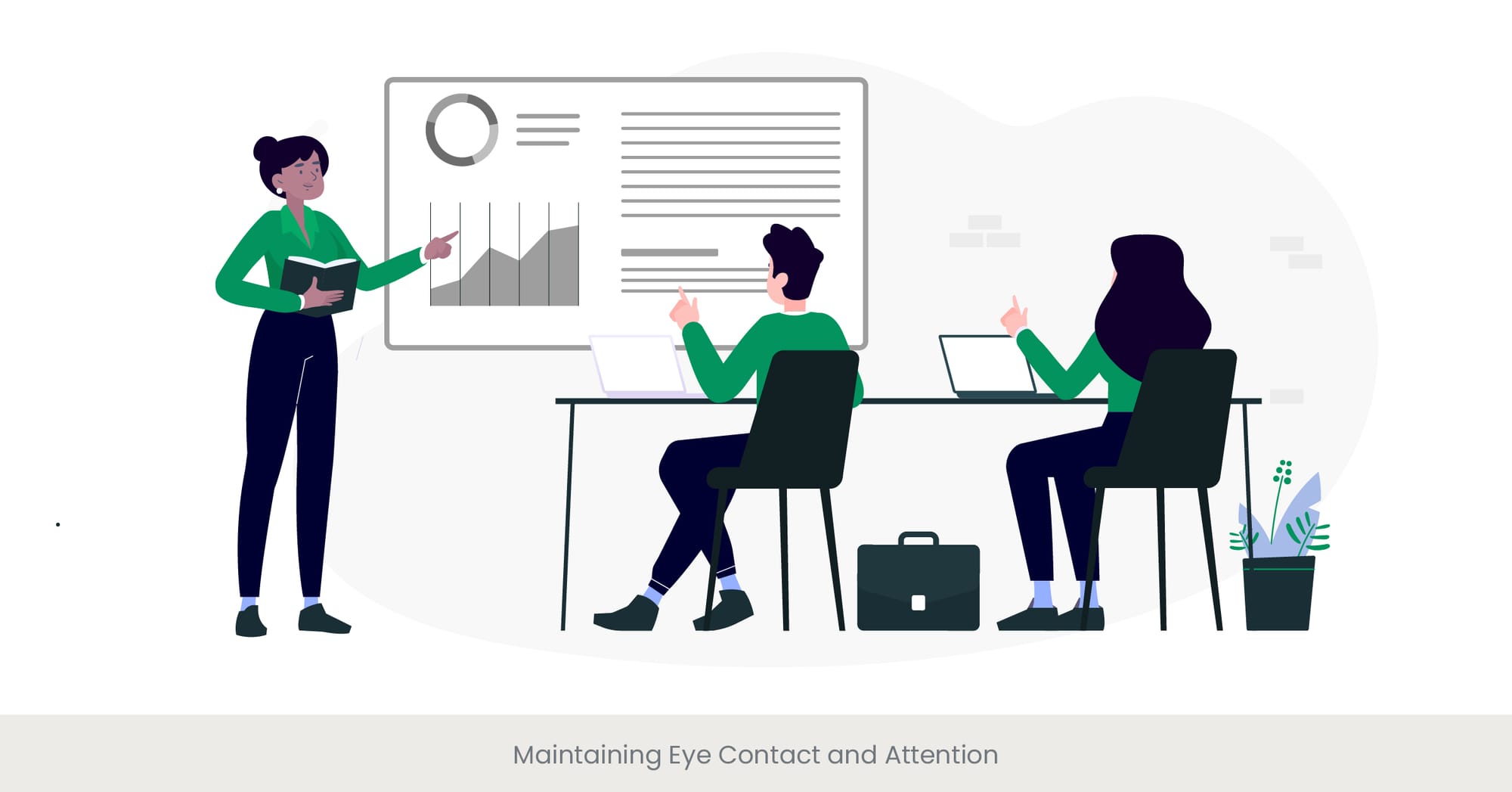
Engagement Through Sight: The Power of Eye Contact in Presentations
Maintaining eye contact is a fundamental skill in effective presentation delivery. It establishes a connection with the audience, demonstrates confidence, and helps keep the audience engaged. Eye contact allows the presenter to gauge audience reactions and adjust their delivery accordingly, ensuring the message resonates well and is impactful.
The Importance of Visual Connection in Historical Contexts
Throughout history, influential leaders and speakers have recognized the power of eye contact in persuading and commanding attention. Eye contact is not just a modern-day presentation technique but has been used effectively across different cultures and eras to convey sincerity, earn trust, and assert authority.
Practical Examples of Effective Eye Contact
Consider how powerful political figures like Barack Obama use eye contact to draw listeners into a conversation, making each member feel addressed and involved. In the corporate world, executives use eye contact during presentations to strengthen their messages about company missions or new initiatives, making their communication more personal and direct.
Research and Recommendations on Eye Contact
Studies show that maintaining appropriate eye contact—about 70% of the time—can significantly increase the speaker's credibility and the audience's retention of the information presented in person to. Experts suggest techniques for improving eye contact, such as the 'triangle method', where the speaker looks at one eye, then the other, and then the mouth, cycling through this pattern to further maintain eye contact for natural and effective engagement.
Utilizing Space and Movement on Stage
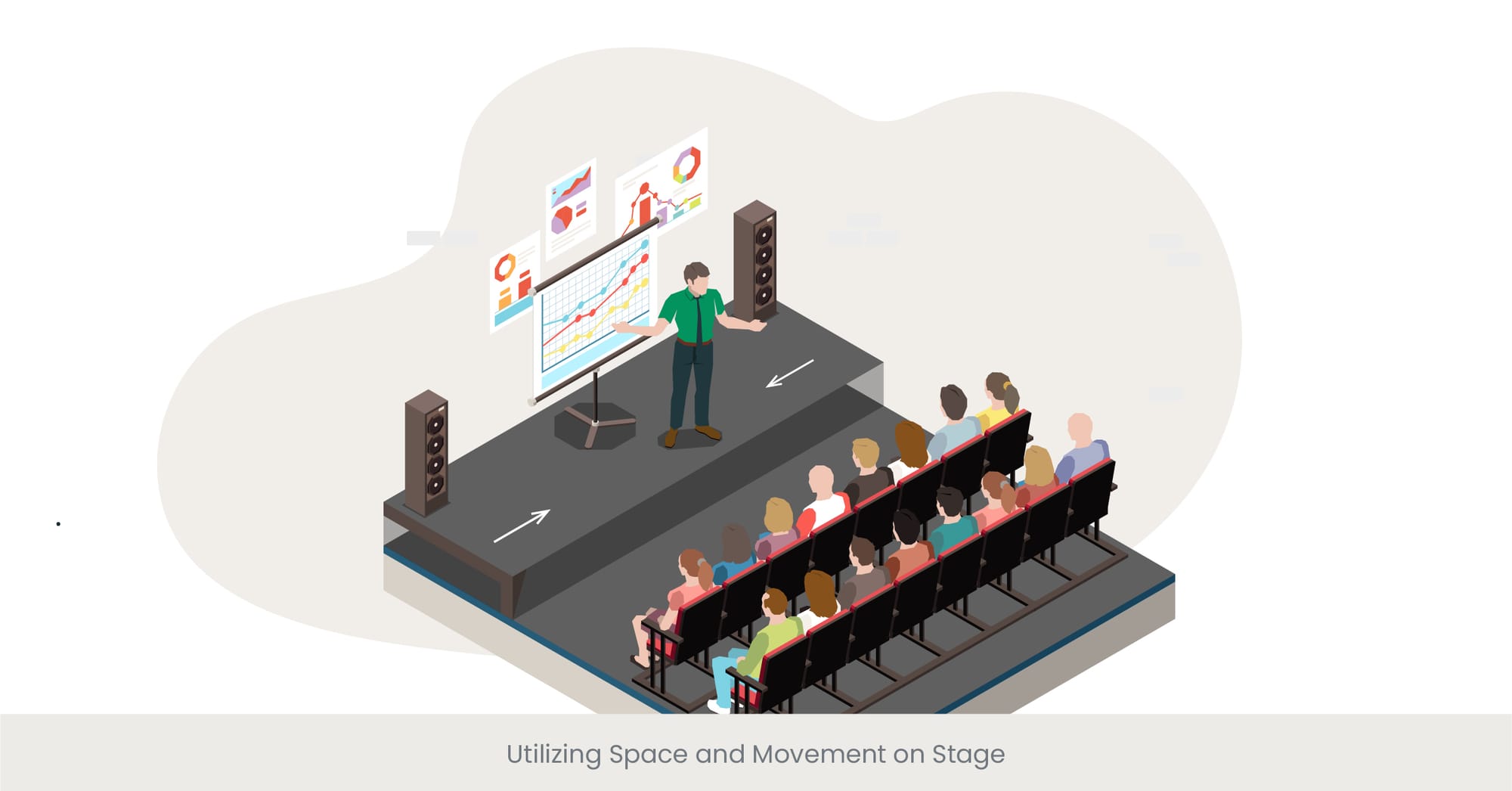
Mastering Spatial Dynamics: Enhancing Presentations through Movement
Effective use of space and movement on stage can greatly enhance the impact of a presentation. It helps in demonstrating confidence, keeps the audience visually engaged, and can be used to emphasize key points. Strategic movement around the stage can make the presentation feel more dynamic and alive, rather than static and monotonous.
The Evolution of Stage Presence in Public Speaking
Historically, great orators understood the importance of using the stage to their advantage. From ancient philosophers roaming public squares to modern keynote speakers utilizing the entire stage, movement has always been a key element in capturing and holding audience attention. Effective use of space can transform a speech into a performance, making it more memorable and engaging.
Case Studies of Successful Stage Utilization
In TED Talks, speakers often use the stage space creatively to reinforce their message. For example, Bill Gates released mosquitoes on stage during a talk on malaria to grab attention and highlight the immediacy of the issue. Such strategic use of space not only captures attention but also significantly enhances the message's impact.
Supporting Evidence and Expert Opinions on Stage Movement
Research suggests that speakers who effectively use stage space are perceived as more engaging and competent. Experts recommend practices such as walking purposefully to different parts of the stage to engage different sections of the audience or using gestures that complement spatial movements. These techniques are supported by studies emphasizing that dynamic movement can aid in better retention of information by the audience.
Projecting Confidence and Authority
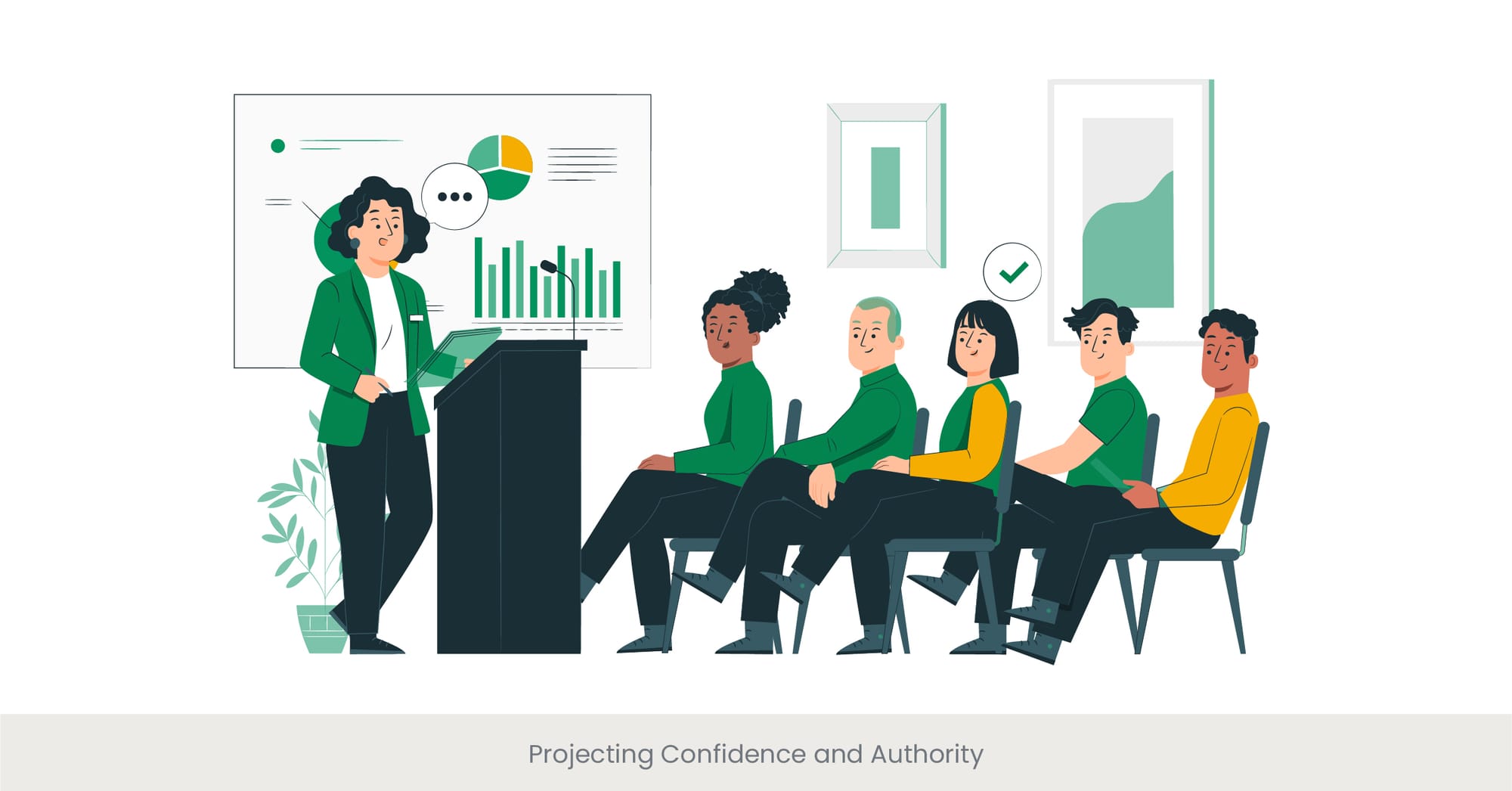
Commanding the Room: Techniques for Exuding Confidence
Projecting confidence, knowledge and authority during a presentation is crucial for creating, capturing and sustaining audience interest. Confidence is not just felt internally but also expressed through body language, voice tone, and the content's delivery. A confident speaker commands attention, facilitates trust, and conveys their message with conviction.
Historical Insights on Leadership and Presentation
Throughout history, successful leaders and orators have demonstrated that confidence can significantly influence an audience. For example, Winston Churchill's speeches during World War II exemplified how confidence and authority could inspire a nation. His firm, decisive delivery and unwavering confidence were pivotal in boosting public morale and support.
Real-Life Examples of Confidence in Action
In the business world, leaders like Sheryl Sandberg and Steve Jobs are known for their authoritative and confident presentation styles, which not only conveyed their business messages effectively but also enhanced their persona as leaders. Their ability to present with certainty and assurance significantly influenced their audiences and stakeholders.
Studies and Strategies for Enhancing Personal Confidence
Psychological studies indicate that certain behaviors, such as practicing power poses or speaking with assertiveness, can enhance one person's perceived authority and self-confidence. Experts suggest that preparation is key—knowing your material well can naturally boost your confidence. Additionally, techniques such as rehearsing in front of a mirror or recording practice sessions can help speakers gain confidence in their delivery.
Managing Presentation Pace and Timing
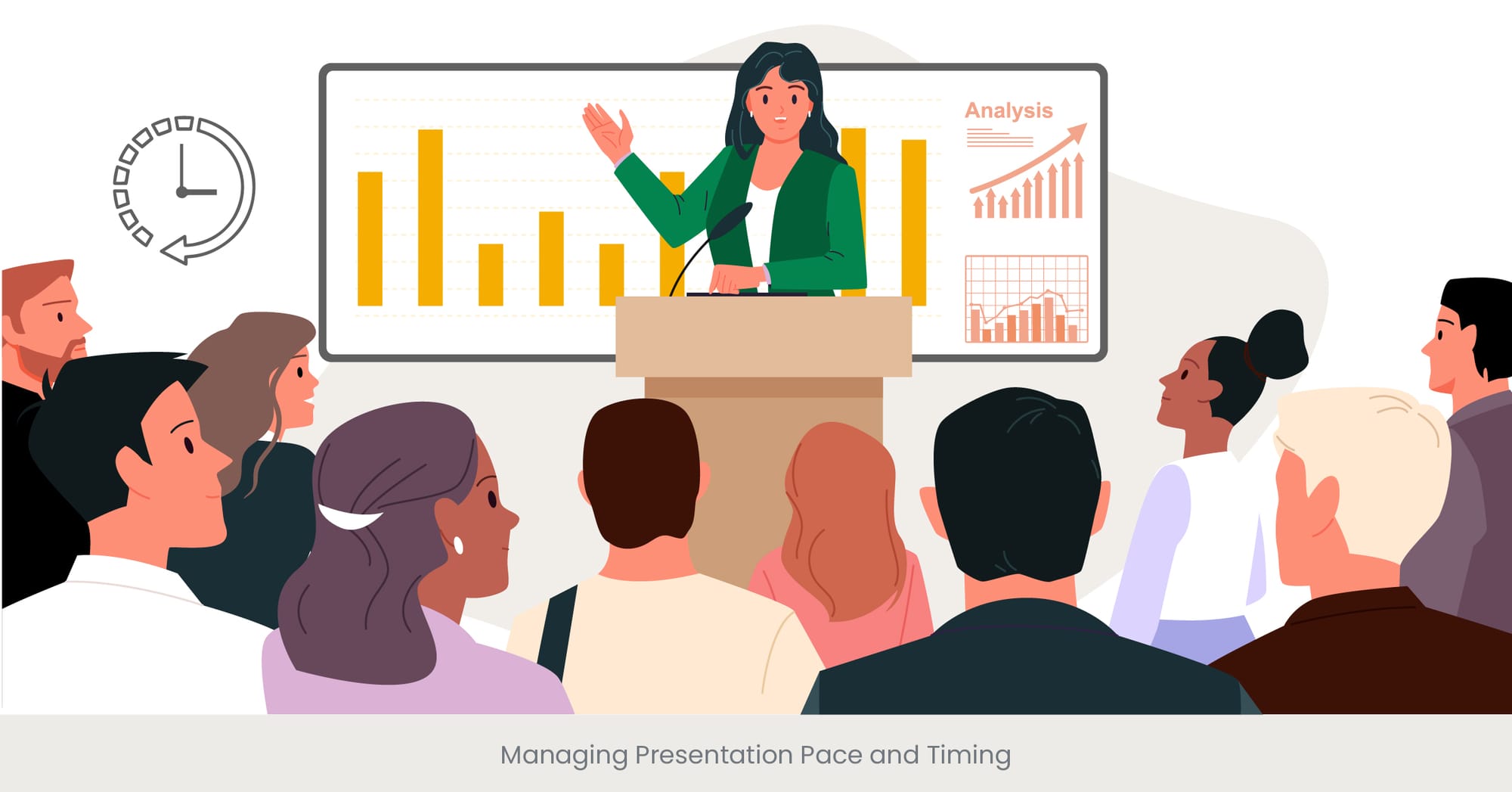
The Rhythm of Speech: Optimizing Pace for Maximum Impact
Effective management of pace and timing is crucial in presentation delivery. The right pace helps maintain audience interest, enhances comprehension, and allows the speaker to emphasize important points. Adjusting the speed of delivery and making deliberate pauses can make the presentation more engaging and easier to follow.
The Significance of Timing in Historical Orations
Throughout history, the most memorable speeches have used pace masterfully. Martin Luther King Jr.'s deliberate pauses during his "I Have a Dream" speech allowed his profound words to resonate deeply with his audience, giving them time to reflect on the messages conveyed. Effective pacing can turn a good speech into an unforgettable one by perfectly timing the delivery of key points.
Illustrative Examples of Effective Pacing
In the corporate world, executives often adjust their speaking pace during earnings calls to emphasize positive results or to carefully address challenges. This strategic variation not only captures attention but also guides the listener's emotional response to the information being presented.
Empirical Support and Practical Tips on Timing
Research in speech communication suggests that varying the pace can help retain the audience's attention and enhance message retention. Techniques such as the 'traffic light rule', where the first 30 seconds of a speech are crucial to capturing attention (green light), the middle part should hold and build interest (yellow light), and the final part should drive home the message (red light), can guide presenters in managing their speech timing effectively.
Incorporating Pauses for Emphasis and Clarity
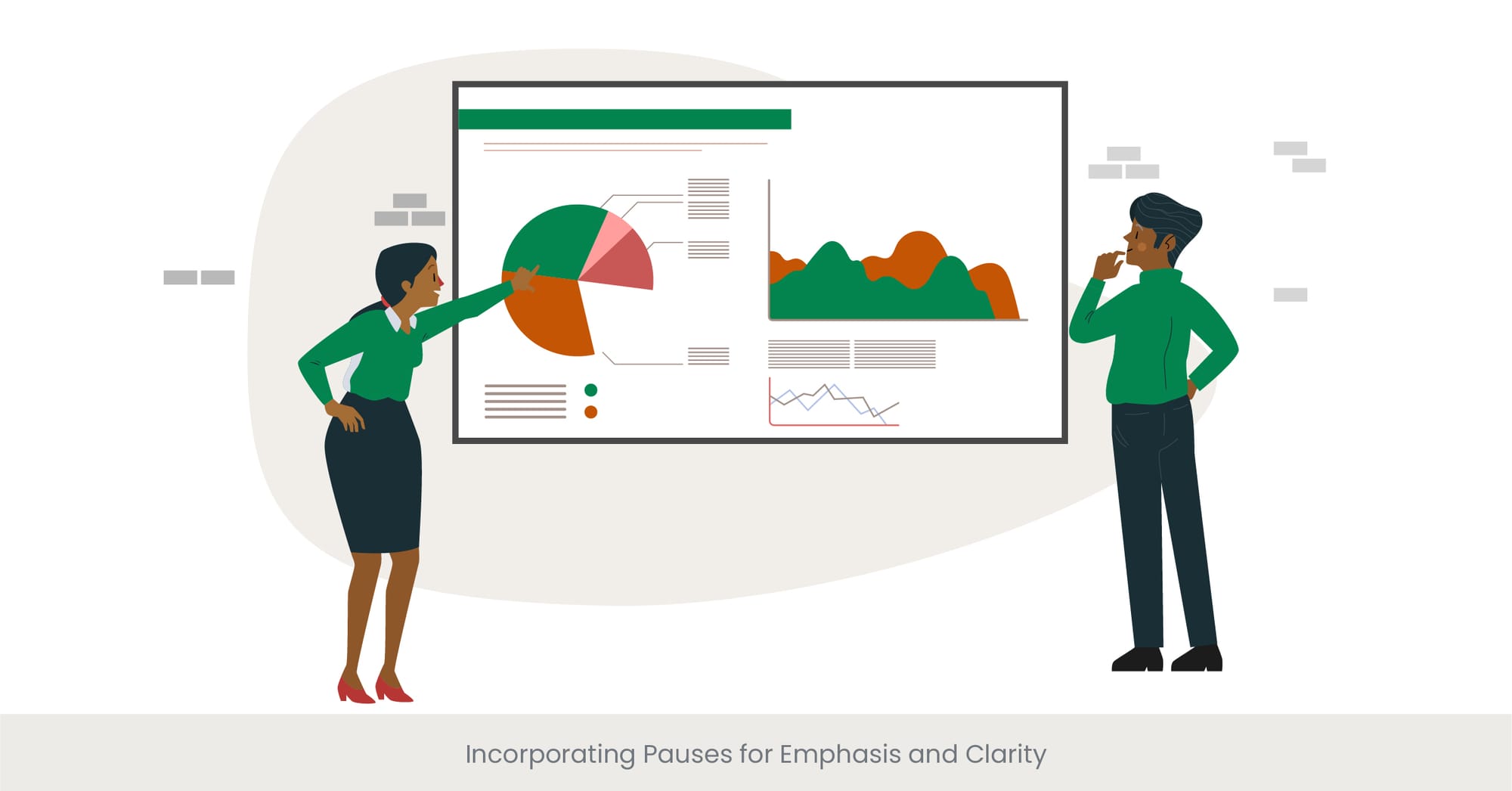
The Strategic Silence: Using Pauses to Enhance Communication
Incorporating pauses in a presentation is a powerful technique to add emphasis and clarity to your message. Strategic pauses allow the audience time to absorb and reflect on what has been said, enhancing understanding and engagement. They can also be used to highlight important points, create suspense, or give the speaker a moment to collect their thoughts.
Historical Context and the Power of Pauses
Historically, master orators like Cicero and Abraham Lincoln used pauses effectively to command attention and add dramatic effect to their speeches. These pauses were not mere breaks in speech but carefully placed silences that reinforced the gravity of their words, allowing their messages to resonate more deeply with the audience.
Real-World Examples of Effective Pausing
Consider the speeches of contemporary leaders who use pauses to great effect. For instance, during product launches, Apple's late CEO Steve Jobs famously used pauses to build anticipation and make the audience hang on his every word. This technique not only captured attention but significantly amplified the impact of his message.
Research Insights and Expert Techniques for Pausing
Research shows that speakers who use pauses are often perceived as more persuasive than those who do not. Experts recommend using pauses before and after key points to signal their importance to the audience. Additionally, pauses can help manage public speaking anxiety by giving speakers short breaks to regain composure. Effective training in pause techniques can dramatically improve a speaker's delivery, making their communication more powerful and convincing.
Using Visual Aids and Props Effectively
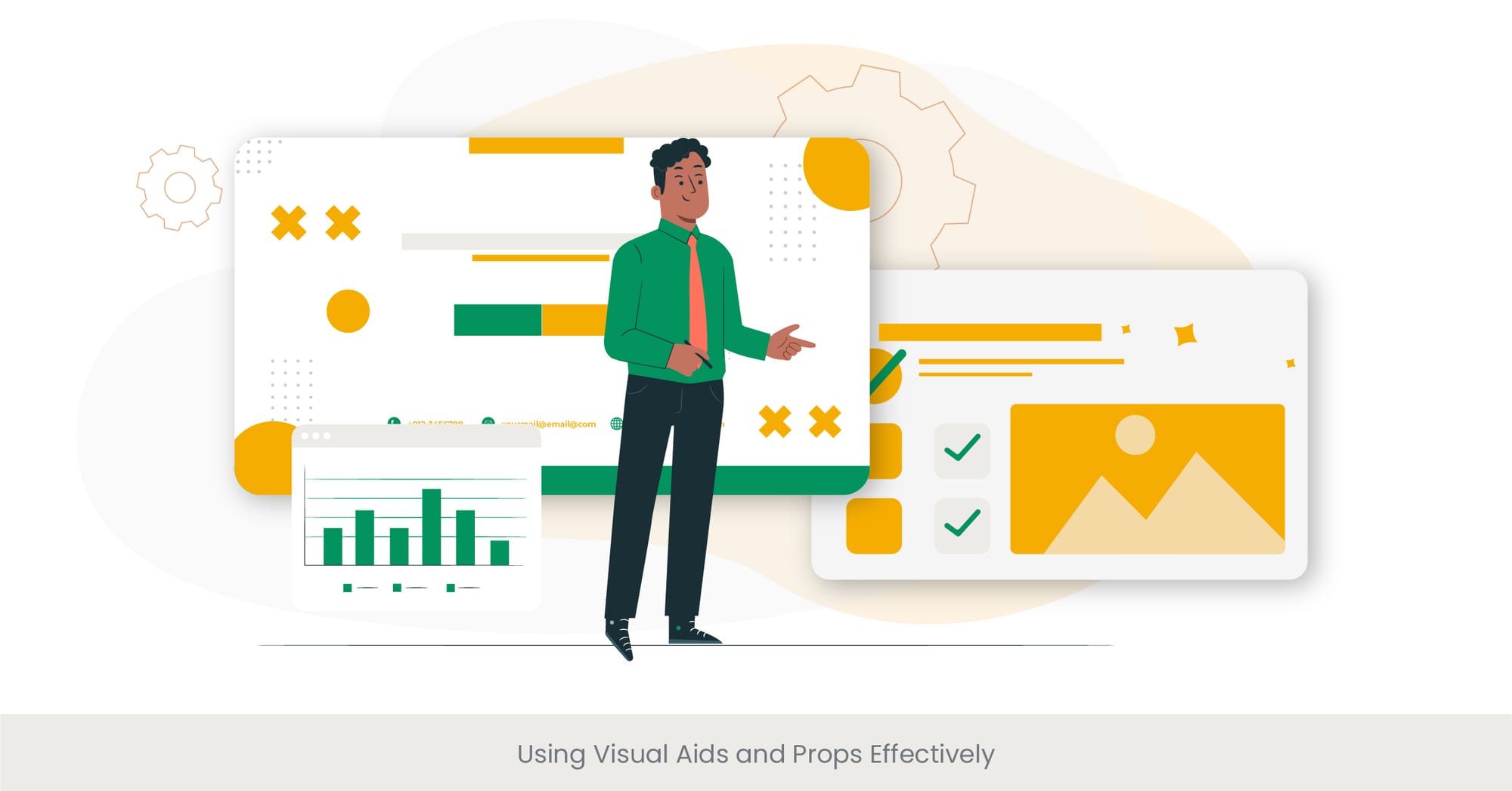
Enhancing Presentations with Visuals and Props
Visual aids and props can significantly enhance the effectiveness of a presentation by providing visual stimuli that support and clarify the spoken word. Effective use of these tools in effective presentations can make complex information more accessible, keep the audience engaged, and reinforce key points, making the presentation more memorable.
The Evolution of Visual Support in Communication
Historically, visuals have played a crucial role in communication. From ancient cave paintings to modern PowerPoint presentations, visual aids have evolved to help storytellers and speakers illustrate their points more vividly. In the business and educational sectors, visuals have become indispensable tools for conveying data, ideas and concepts efficiently.
Case Studies of Successful Use of Visual Aids
In TED Talks and corporate presentations, skilled presenters use slides, charts, and even physical objects to illustrate their points. For example, Bill Gates once opened a jar of mosquitoes during a talk on malaria to drive home a point about the reality of the disease's impact. This dramatic prop helped the audience connect emotionally with the topic and underscored the urgency of his message.
Expert Opinions and Research on Visual Communication
Research indicates that people remember visual information far better than verbal information alone. Studies suggest that presentations with visual aids are 43% more persuasive than those without. Experts recommend matching visual aids with speech points for maximum effect and using high-quality images and diagrams to maintain professional standards. Additionally, training on how to effectively integrate visual aids into presentations can greatly improve a speaker's effectiveness.
Practicing Vocal Variety and Expression
Cultivating Interest Through Vocal Dynamics
Vocal variety and expression are essential components of engaging public speaking. By varying pitch, tone, volume, and pace, a confident public speaker, can keep the audience interested and emotionally invested in the presentation. Effective vocal variety helps to break the monotony of a speech and can emphasize key points, making the presentation more dynamic and memorable.
The Role of Vocal Expression in Historical Speeches
Historically, the use of vocal variety has distinguished mediocre speakers from great ones. Famous orators like Winston Churchill and Martin Luther King Jr. skillfully used their voices to convey passion, urgency, and conviction, stirring emotions and inspiring action among their listeners. Their ability to modulate their voices contributed significantly to their persuasive power.
Illustrating Vocal Variety with Modern Examples
In modern public speaking, vocal variety continues to play a critical role. For instance, motivational speakers like Tony Robbins use shifts in volume and pace to energize the audience, create impact, and drive important points home. These techniques ensure that the speech remains engaging throughout and that key messages are highlighted effectively.
Research and Techniques for Enhancing Vocal Variety
Studies on speech communication have shown that speakers who use a greater range of vocal expressions are more likely to hold the audience's attention and be perceived as charismatic. Voice coaching and public speaking courses often focus on exercises to expand vocal range, practice pitch variation, and control pacing. Techniques such as the use of melody in speech or strategic pauses can enhance vocal delivery, making it more effective and appealing.
Final Reflections on Mastering Delivery Techniques
Mastering delivery techniques is essential for anyone looking to enhance their public speaking and presentation skills. As we've explored, this involves a comprehensive understanding and application of various strategies, from effective body language and vocal variety to strategic use of visuals and mastering pacing. Each element plays a crucial role in how a message is perceived and can dramatically influence the effectiveness of a presentation.
Integrating and Practicing Delivery Presentation Skills Techniques
To truly excel in public speaking, integrating these techniques into regular practice is crucial. This requires not only understanding the theory behind each technique but also constant practice and feedback. Engaging in a presentation skills training course or seeking coaching from a team of experienced professionals can provide valuable insights and accelerate skill development.
The Continuous Journey of Improvement
Mastering these skills is not a one-time achievement but an ongoing process of refinement, training and adaptation. As audiences and environments change, so too must our methods of presenting them and approaches to engaging with them. Keeping up-to-date with new tools, techniques, and technologies in presentation delivery will ensure that your skills remain relevant and impactful.
Empowering Future Presentations
With these skills, speakers can look forward to more confident and powerful presentations. Whether addressing a small team meeting or a large conference, the ability to deliver messages with clarity, persuasion, and impact is invaluable. By continually refining these skills, you can transform not only your presentations but also your broader communication abilities, which are critical in both professional life and personal contexts.
By embracing the art and science of effective presentation skills and delivery, you can ensure that your messages are not just heard but remembered and acted upon. It's about making every word count and every moment in front of an audience impactful.
Frequently Asked Questions (FAQs)
How can you improve your own presentation skills and public speaking skills?
Improving presentation skills involves practice, feedback, and learning from experienced speakers. Engage in regular training, use video recordings to review your performance, and incorporate feedback to refine your presenting techniques.
What are the 5 P's of good presentation skills?
The 5 P's stand for Plan, Prepare, Practice, Present, and Post-Evaluate. Each step is crucial in developing effective presentation skills and delivering an effective presentation.
What are 10 qualities of a good presentation?
Clarity, engagement, structure, subject relevance, subject passion, visual aids, adaptation, interaction, confidence, and professionalism are key qualities that make a presentation effective.
What activity can help you improve your or improve presentation skills?
Participating in public speaking clubs like Toastmasters or engaging in improvisation workshops can significantly enhance and improve your presentation skills through practical experience and professional development.
What are the 7 presentation skills?
These include researching your topic, organizing content, mastering delivery techniques, using visual aids, engaging with the audience, handling questions effectively, and managing your own presentation and tools.
What are the 4 types of presentation skills?
Informative, instructional, persuasive, and inspirational are four main types of presentation styles, each with unique needs and objectives requiring different skills and approaches.
What is presentation skill training?
Presentation skill training involves structured learning experiences that help individuals improve their ability to communicate effectively in front of an audience, covering various techniques and practical exercises.
What is the 5 5 5 rule in PowerPoint?
The 5 5 5 rule suggests using no more than five words per line, five lines per slide, five slides and five text-heavy slides in a row to keep PowerPoint presentations clear and engaging.
How to improve your presentation skills?
Continuously seek opportunities to present, utilize constructive criticism, study effective speakers, and train in specific areas like voice control, body language, and content organization skills.
What are 7 elements of powerful presentations?
A powerful presentation should include a clear objective, a well-structured narrative, compelling visuals, audience engagement strategies, confidence in delivery, effective pacing, and a strong conclusion.
What is the course becoming a better presenter?
This course typically focuses on professional development of practical skills and techniques for effective public speaking, including managing anxiety, using technology, and engaging diverse audiences.
What is the one day presentation skills course?
A one-day course is an intensive workshop designed to teach fundamental presentation skills quickly, ideal for professionals who need to improve their abilities in a short time.



%20(1).jpg)
%20(1).jpg)
